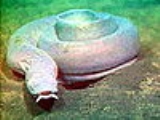
Pacific hagfish
Encyclopedia
The Pacific hagfish is a species of hagfish
. It lives in the mesopelagic to abyssal
Pacific ocean
, near the ocean floor. It is a jawless fish
, a throwback to the Paleozoic Era when fish evolved. Deep-sea diving equipment is known to have been fouled by large amounts of hagfish slime
near the bottom of the ocean, extruded by the eel-like fish when they are alarmed.
The hagfish is notorious for its slimy skin. When disturbed, it oozes proteins from slime glands in its skin that respond to water by becoming a slimy outer coating, expanding it into a huge mass of slime. This makes them very unsavory to predators. Hagfish create large amounts of slime in just minutes. One scientist researching this protein excretion concluded that a single hagfish could fill an entire barrel with slime in less than 100 minutes.
In many parts of the world, including the US, hagfish-skin clothing, belts, or other accessories are advertised and sold as "yuppie leather" or "eel-skin" (hagfish are not true eel
s, which are bony fish
with jaw
s).
The hagfish is eaten in Korea and other Asian countries, along with its eggs and its slime. The section of the fishing industry devoted to hagfish-fishing has grown in recent years.
The hagfish has feelers that enable it to find food more easily. It is an opportunistic feeder, and eats dead and rotting animals that float down from the pelagic zone of the ocean. Swarms of hagfish will descend upon and penetrate the carcass and devour it from the inside out. This mode of marine waste disposal allows the hagfish to efficiently gain nutrients. The resultant rarity of rotting animals on the sea-floor is one of the factors that modulates global cycles of phosphorus, carbon and nitrogen.
This fish is often referred to as the "slime eel". This is an incorrect common name / nick name.
Hagfish
Hagfish, the clade Myxini , are eel-shaped slime-producing marine animals . They are the only living animals that have a skull but not a vertebral column. Along with lampreys, hagfish are jawless and are living fossils whose next nearest relatives include all vertebrates...
. It lives in the mesopelagic to abyssal
Abyssal zone
The abyssal zone is the abyssopelagic layer or pelagic zone that contains the very deep benthic communities near the bottom of oceans. "Abyss" derives from the Greek word ἄβυσσος, meaning bottomless. At depths of 4,000 to 6,000 metres , this zone remains in perpetual darkness and never receives...
Pacific ocean
Pacific Ocean
The Pacific Ocean is the largest of the Earth's oceanic divisions. It extends from the Arctic in the north to the Southern Ocean in the south, bounded by Asia and Australia in the west, and the Americas in the east.At 165.2 million square kilometres in area, this largest division of the World...
, near the ocean floor. It is a jawless fish
Agnatha
Agnatha is a superclass of jawless fish in the phylum Chordata, subphylum Vertebrata. The group excludes all vertebrates with jaws, known as gnathostomes....
, a throwback to the Paleozoic Era when fish evolved. Deep-sea diving equipment is known to have been fouled by large amounts of hagfish slime
Mucus
In vertebrates, mucus is a slippery secretion produced by, and covering, mucous membranes. Mucous fluid is typically produced from mucous cells found in mucous glands. Mucous cells secrete products that are rich in glycoproteins and water. Mucous fluid may also originate from mixed glands, which...
near the bottom of the ocean, extruded by the eel-like fish when they are alarmed.
The hagfish is notorious for its slimy skin. When disturbed, it oozes proteins from slime glands in its skin that respond to water by becoming a slimy outer coating, expanding it into a huge mass of slime. This makes them very unsavory to predators. Hagfish create large amounts of slime in just minutes. One scientist researching this protein excretion concluded that a single hagfish could fill an entire barrel with slime in less than 100 minutes.
In many parts of the world, including the US, hagfish-skin clothing, belts, or other accessories are advertised and sold as "yuppie leather" or "eel-skin" (hagfish are not true eel
Eel
Eels are an order of fish, which consists of four suborders, 20 families, 111 genera and approximately 800 species. Most eels are predators...
s, which are bony fish
Osteichthyes
Osteichthyes , also called bony fish, are a taxonomic group of fish that have bony, as opposed to cartilaginous, skeletons. The vast majority of fish are osteichthyes, which is an extremely diverse and abundant group consisting of over 29,000 species...
with jaw
Jaw
The jaw is any opposable articulated structure at the entrance of the mouth, typically used for grasping and manipulating food. The term jaws is also broadly applied to the whole of the structures constituting the vault of the mouth and serving to open and close it and is part of the body plan of...
s).
The hagfish is eaten in Korea and other Asian countries, along with its eggs and its slime. The section of the fishing industry devoted to hagfish-fishing has grown in recent years.
The hagfish has feelers that enable it to find food more easily. It is an opportunistic feeder, and eats dead and rotting animals that float down from the pelagic zone of the ocean. Swarms of hagfish will descend upon and penetrate the carcass and devour it from the inside out. This mode of marine waste disposal allows the hagfish to efficiently gain nutrients. The resultant rarity of rotting animals on the sea-floor is one of the factors that modulates global cycles of phosphorus, carbon and nitrogen.
This fish is often referred to as the "slime eel". This is an incorrect common name / nick name.

